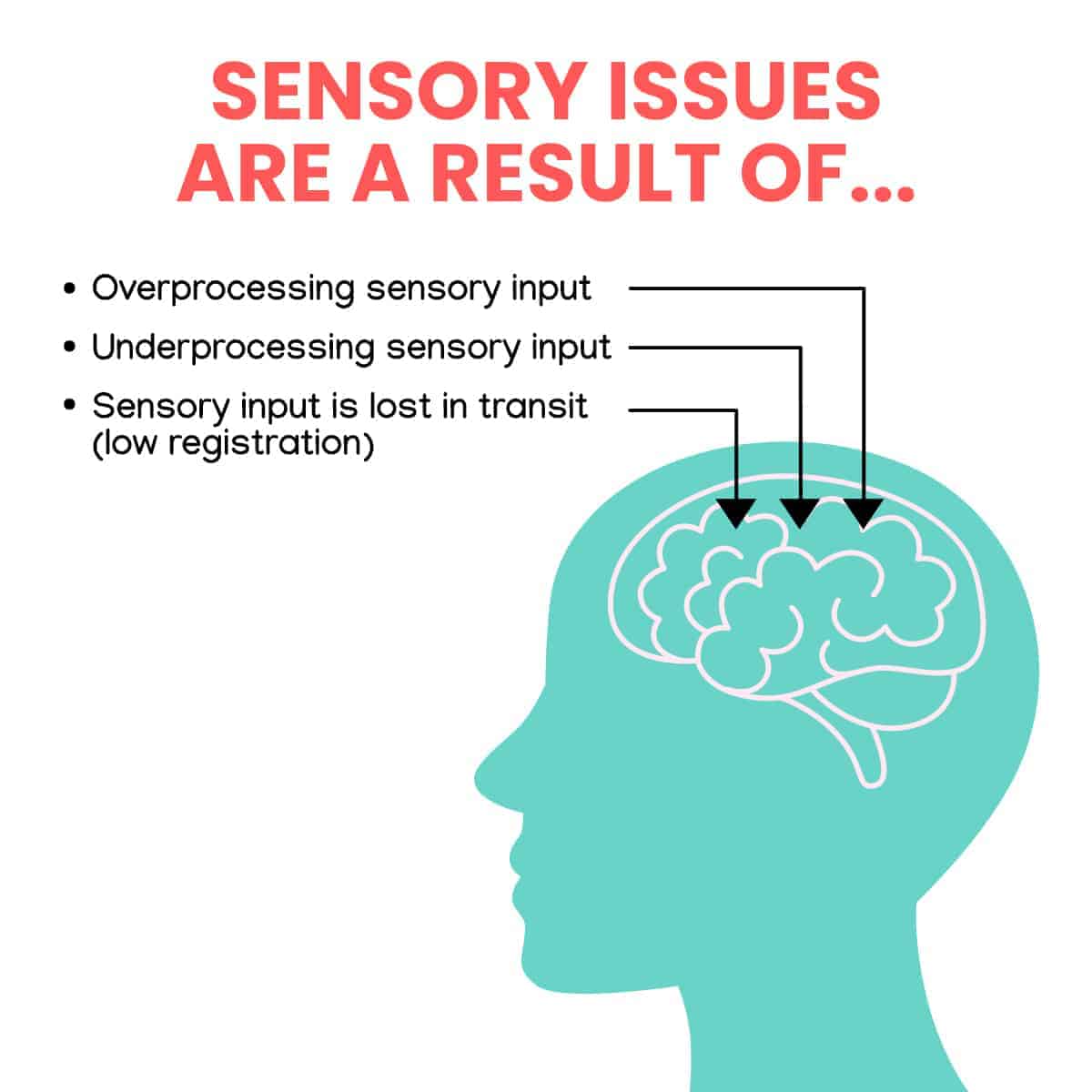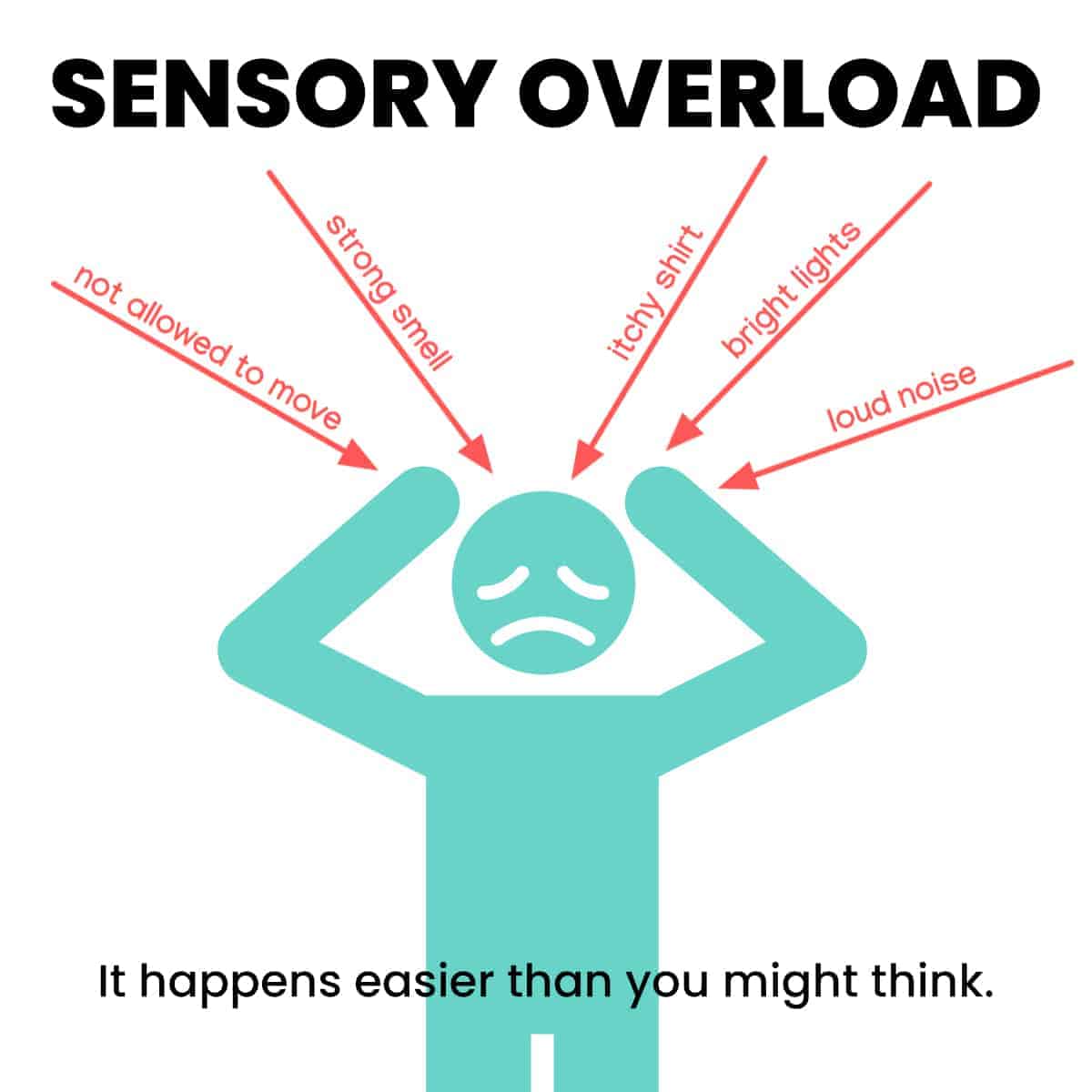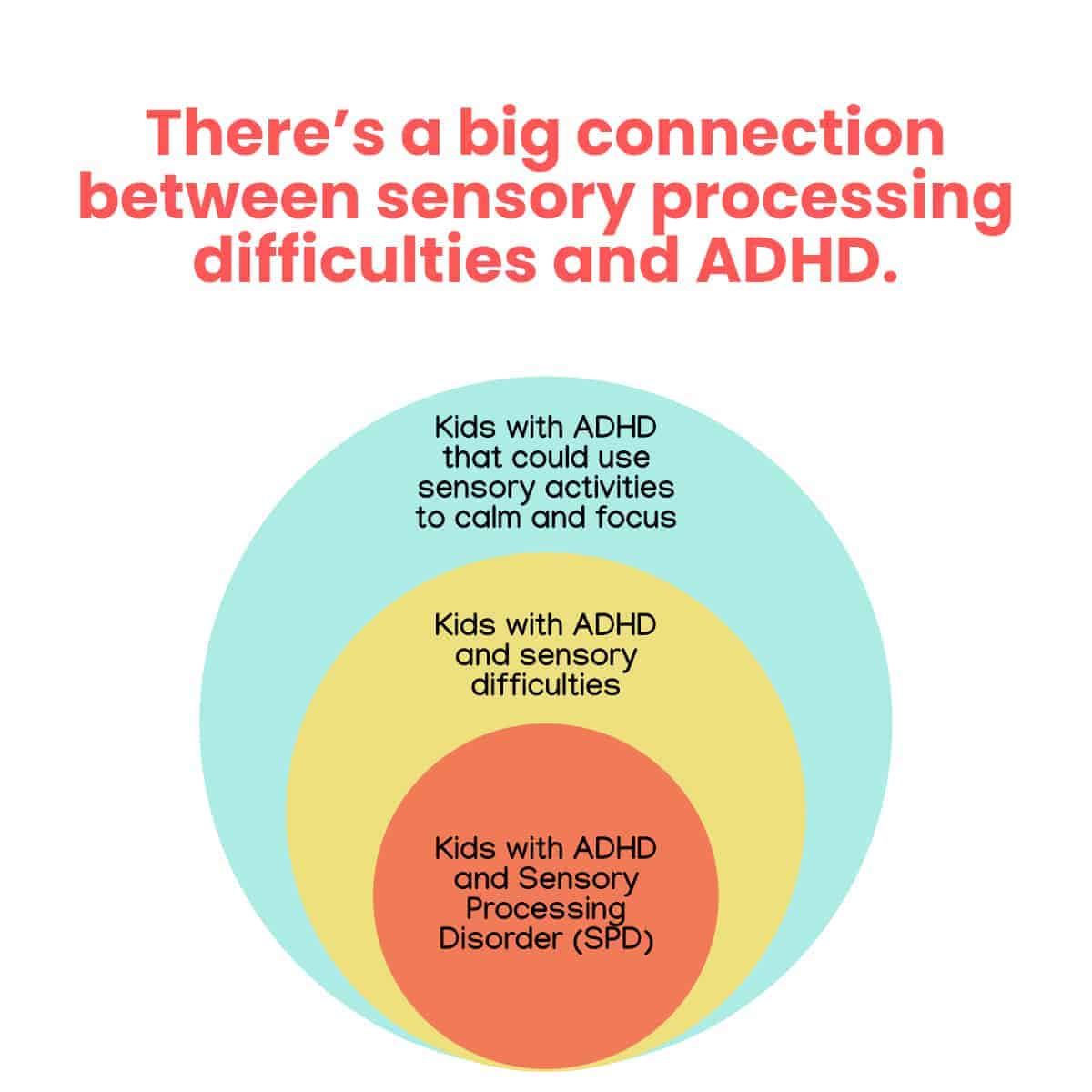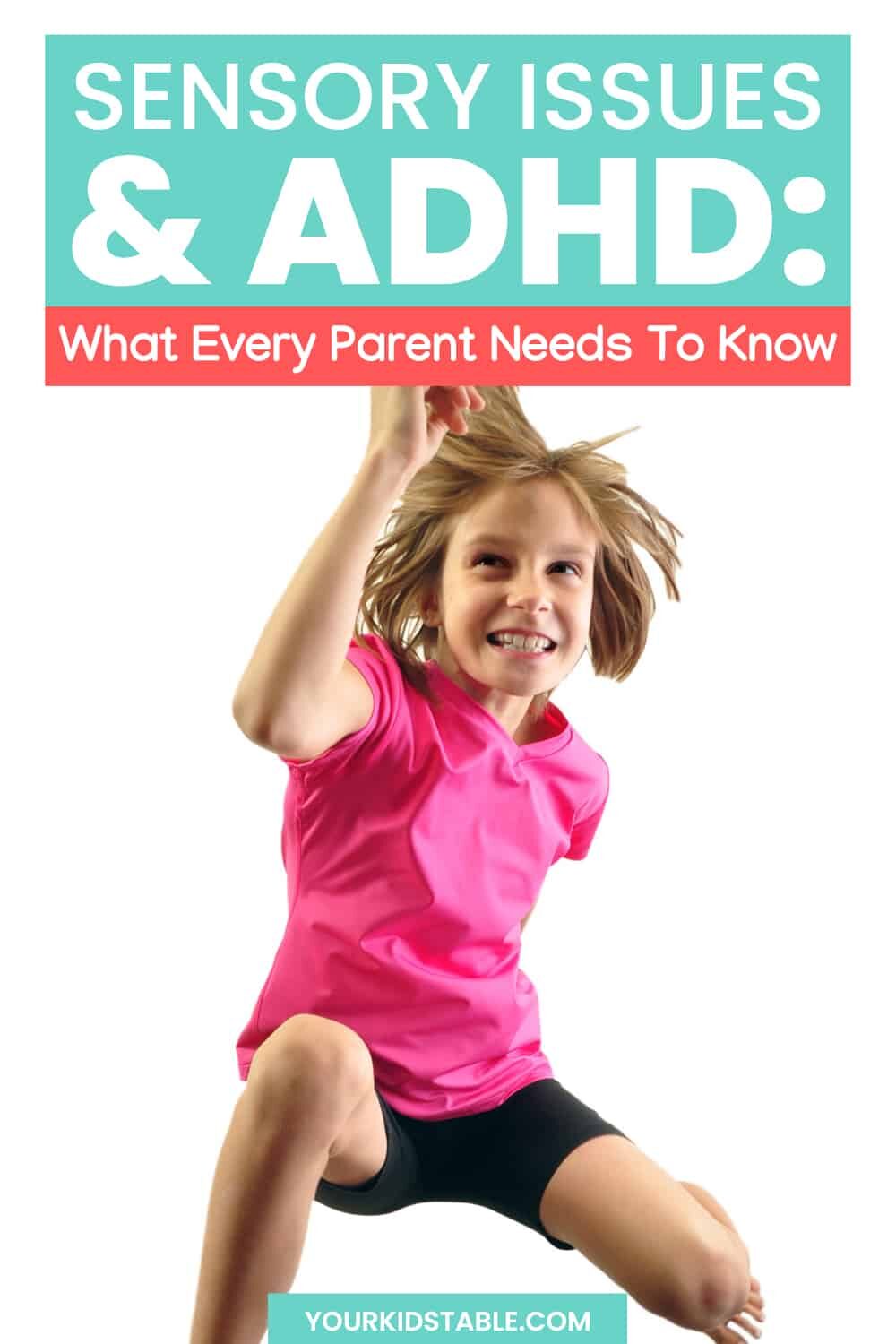There’s a big connection between ADHD and sensory issues that’s often not explained to parents, but can have a big impact on sensory overload, social interactions, and focus!
Attention Deficit Hyperactivity Disorder, or ADHD, is a common neurodevelopmental condition that’s most often diagnosed in children. Although, adults can receive the diagnosis too!
In 2016, the CDC estimated that about 10% of children have ADHD.
That’s quite a big number.
As an occupational therapist, I’ve worked with a lot of kids with ADHD. Many of them were also struggling with sensory issues.
On the surface, some of the common signs of ADHD can be overlooked as a result of the diagnosis itself. But, as an OT, I could often connect the big emotional responses, difficulty with social interaction, and/or the impulsive behavior that kids with ADHD often display directly to sensory processing difficulties and sensory dysregulation.
That means that the right sensory activities, sensory integration therapy, or a sensory based treatment plan could make a massive positive impact on those challenges and others in their everyday life.
The connection to sensory processing issues goes even deeper for kids with ADHD though, because many kids with ADHD will have texture issues, noise sensitivity, or sensory issues with clothing, to name just a few.
What Are Sensory Issues Exactly?
Sensory issues are a result of the brain not processing the sensory input it receives well. The brain is constantly receiving sensory information from all of our 8 senses (there’s the proprioceptive, vestibular, and interoceptive “hidden” senses, too.)

If the brain over processes the sensory stimuli, under processes it, or the input get’s lost in transit, then we see sensory issues.
Because sensory issues arise as a result of this under, over, or lost processing (also called low registration) for any or all of the 8 different senses a child can display dozens and dozens of signs of sensory issues.
Unfortunately, with a lack of knowledge and training in sensory processing, many health care professionals, including some pediatrician’s, don’t make the connection for parents that the odd, quirky, or frustrating behaviors they’re seeing in their child are explained by the way their brain is processing the large multitude of sensory stimuli it’s constantly receiving.
Or, that specialized sensory activities can improve the sensory processing that isn’t working well!
Common Sensory Signs for a Child with ADHD
Children with ADHD can potentially have all sort of sensory issues, but most will fit into one of two categories:
- Sensory sensitivity (this is when the brain over processes sensory input)
- Sensory seeking (this is when the brain under processes sensory input)
Kids with a sensory sensitivity may freak out or avoid certain types of sensory stimuli such as:
- loud noises
- bright lights
- textures of food (think picky eater)
- types of clothing
- smells
- movement (may not like swings, slides, riding a bike, etc.)
Children that are seeking sensory stimuli are often trying to get more and more and more of a particular sensation. They’re often described as wild, inattentive, and as having a hard time following directions.
Sound familiar? These are common ADHD symptoms, too. More on that in a minute.
To be more specific, you may see sensory seekers:
- climb high furniture dangerously
- spin in circles
- play rough and hard with other kids, siblings, or adults in their life
- squeeze into tight spots
- hit, bite, or push (although there’re other possible explanations for these behaviors)
- jump up and down all the time
- lick everything
- smell everything
- touch everything
- stare at shiny or spinning objects
Honestly, this list could go on and on. Some kids find really unique ways for getting the sensory input they crave, if you aren’t sure if it’s related to their sensory processing, leave us a comment below.
ADHD and Sensory Overload…
All of these sensory issues, or sensory needs as I like to think of them, can reach a boiling point and cause a child with ADHD to go into sensory overload.
Sensory overload can happen very quickly, especially if a child isn’t verbal or has poor communication skills.
It’s often triggered when there’s too much sensory input coming into a child’s brain and they literally can’t take anymore.

When a child experiences sensory overload, they may become non-responsive, difficult to communicate with, or hit themselves or other’s.
Sometimes sensory overload can lead to a sensory meltdown, which is VERY different than a tantrum although they may look similar. When a child has a sensory meltdown, they may become explosive, violent, scream, scratch, hit, bite, or run away.
Their sensory system had too much and they aren’t able to think in a sensory meltdown, they’re reacting, often confused and overwhelmed themselves.
Kids with ADHD might experience a sensory meltdown when they aren’t allowed to move or are required to sit still for too long, particularly if they fall into sensory seeking.
Are Sensory Issues Part of ADHD?
The big question at this point is… Are sensory issues part of ADHD?
Here’s what we know, lots of kids have sensory issues whether they have ADHD, autism spectrum disorder (ASD), or not. BUT, a large portion of kids with ADHD appear to also have sensory issues.
According to the Star Institute, 40% of children with ADHD likely have SPD as well. While some symptoms of ADHD and sensory processing disorder are the same, the causes appear to be different.
ADHD appears to be linked with faulty neurotransmitters and SPD is being linked to levels of white matter in the brain.
That being said, many more children with ADHD will have sensory difficulties that could impact their daily life, but wouldn’t qualify for a SPD diagnosis.
And the portion of kids that don’t have significant differences in their sensory processing would likely benefit from sensory activities that are known to calm and focus in general.
Look at this chart below, it gives you an overview picture of how sensory issues or Sensory Processing Disorder may affect a child with ADHD:

It’s also important to note that one study linked children that have ADHD, an anxiety disorder and oppositional defiant disorder are more likely to have severe sensory issues.
In any of these instances, it appears (and I believe) that the vast majority, if not all kids with ADHD, either need or would benefit from targeted sensory strategies and activities or an individualized sensory diet.
Can ADHD Cause Sensory Issues?
You might also be wondering if your child’s ADHD created the sensory issues. Because CT scans show that ADHD and SPD are caused by different reasons, the answer is no.
But, remember that even if a child with ADHD doesn’t have any sensory issues at all, sensory activities and tools could be very effective in helping them calm and focus.
Can My Child Have Sensory Processing Disorder and ADHD?
To be clear, a child can have both a diagnosis of ADHD and SPD. However, Sensory Processing Disorder has yet to be added to the DSM-V, which is the manual doctors and other clinicians use to give diagnoses. Nor, has it been added to the ICD-10 codes which are needed for insurance billing.
Of course, many professionals, including doctors recognize SPD, even if it’s not an “official” diagnosis.
That can make getting services like occupational therapy for sensory issues difficult to get covered by insurance in some instances.
Occupational therapists do evaluate children for sensory processing difficulties and will give the “unofficial” SPD diagnosis when appropriate. If a child also has ADHD should have no bearing on whether they receive a SPD diagnosis or not.
The occupational therapist is looking through a different lens and should complete a thorough evaluation that would reveal the sensory processing differences, if any, that would need addressed.
Was my child misdiagnosed with ADHD?
At this point, you may be wondering if your child was misdiagnosed? Maybe they have Sensory Processing Disorder, not ADHD after all?
That’s a good question to ask yourself, and your child’s pediatrician and any other professionals that work with your child. If you suspect that your child’s difficulties may be able to be explained by a SPD diagnosis alone, then I’d recommend seeking out an experienced occupational therapist to complete a full sensory processing assessment.
Again, make sure you check with your insurance company for coverage.
However, remember that these two diagnoses can co-exist. It’s entirely possible that a child has both ADHD and SPD, and that they weren’t misdiagnosed at all.
And, when you address the sensory processing disorder side of their challenges, you can see a lot of improvements in a child’s behavior, because sensory activities can improve the connections in the brain. That means you’d see a decrease in those sensory sensitivity or sensory seeking behaviors over time.
Next Steps for Kids with ADHD and Sensory Issues
As an OT, I’m incredibly passionate about parents seeing and then helping the sensory processing difficulties in kids with ADHD. I think they’re so easy to miss because so many of the sensory signs can be explained by ADHD too.
But, when we address the sensory signs, amazing changes and growth can happen for a child.
I’ve been able to witness this with a variety of children, including those with ADHD. It’s remarkable, and almost feels like magic when the right treatment for sensory activities comes together.
That’s why I teach parents how to pinpoint their kids specific needs and address them in our RISE with Sensory course.
You can also seek out sensory integration therapy in your area.
Either way, make sure you grab this helpful free printable…
Get our Free 21 Sensory Red Flags Checklist
We covered some of the big sensory signs in this article, but grab this checklist of 21 sensory red flags you might be missing – even if you know some of your child’s sensory difficulties, parents are often surprised to find out that some of the behaviors on this list are caused by sensory processing too!
Click to get the checklist for free!
More on Sensory Processing
37 Sensory Toys to Help Kids Learn, Communicate, and Calm Down
3 Ways to Figure Out if Your Kid Has Sensory Over or Under Processing
3 Rumors About Kids With Sensory Issues That Aren’t True!
60 Printable Sensory Diet Cards for Kids to Thrive
Did you pin this? (Click here to save it so you can find it again!)
Alisha Grogan is a licensed occupational therapist and founder of Your Kid’s Table. She has over 17 years experience with expertise in sensory processing and feeding development in babies, toddlers, and children. Alisha also has 3 boys of her own at home. Learn more about her here.

Thank you for this insightful post! I learned so much about how sensory issues can impact children with ADHD. The practical tips for identifying triggers and managing sensory overload were especially helpful. I appreciate the validation for parents navigating this journey with their kids!
Thank you for shedding light on the link between sensory issues and ADHD! It’s so comforting to know I’m not alone in navigating these challenges with my child. The tips and strategies you shared are really practical and will help me support my little one better. Looking forward to more insights!
Thank you for shedding light on sensory issues related to ADHD! As a parent, it’s been eye-opening to understand how these challenges can manifest in everyday situations. Your tips on coping strategies are particularly helpful, and I can’t wait to try some of them with my child. It’s comforting to know we’re not alone in this journey.
Thank you for shedding light on sensory issues related to ADHD! As a parent, it’s so helpful to understand how sensory sensitivities can impact my child’s daily life. I appreciate the practical tips you provided for navigating these challenges. It’s comforting to know we’re not alone in this journey!
I am having problems with my child and last year he was fine but this year he is not the same we have not made any changes but when he is at school he runs out of class he is fighting he is not listening
Hi Nicole! So sorry to hear about your son’s issues. You are not alone! First, we would recommend discussing this further with your pediatrician. Next, getting to the root of the sensory issue can be very helpful. We have a free sensory workshop that can help with this! Save your seat here!
Best,
Kalyn
Thank you for this amazing article ! My 9 year old son was diagnosed with adhd and has always struggled with picky eating, he won’t come near certain foods, like rice for example! He is a very picky eater and I always wondered if it had something to do with him having adhd ! He also really loves objects that spin and can watch things that spin for a while! This is such an eye opening article! Thank you so much !
Hi Wafa! Thank you so much for your feedback and sharing your situation with us! So glad to hear that you found this post helpful in regards to your son. There’s so much to learn about sensory! If you’re interested, we have a free workshop that goes into more detail about all things sensory- check it out here!
Best,
Kalyn
Thank you so much for this article! As a school-based OT, this will be very helpful to share with parents and teaching staff.
Hi Lynn! Thank you for your feedback! So glad to hear that you found this post helpful and can utilize it at your school as an OT! We have more resources for therapists that you can find here!
Best,
Kalyn